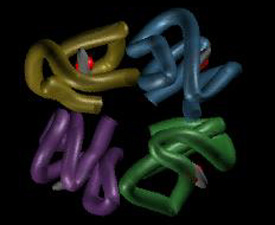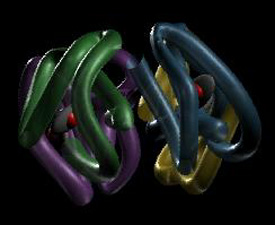



2 alternative "move" sources 1 2
|
This these are a rough 2D story sketch of the elements you would see. The colors aren't finalized, timing is rough, the transitions between the scenes are not the actual ones.These factors will depend on the degree of realism we decide to go with, and general development of the story.. From looking through the available reference, I assumed that what effects the shape of the hemoglobin, which in turn facilitates capture and release of the oxygen, are the acidity and the oxygen pressure. In lungs where acidity is low and environment is more saturated with octagon, it is easy for it to be "captured" by hemoglobin. In peripheral tissues the acidity is higher, and octagon pressure is lower, which forces the octagon to be released. No identification (lettering) was used in this animation. It may be necessary? The sliders on the side can be used set up as an interactive unit. You don't have to be concerned about the difference in the visual appearance of animation storyboards for Animation 1 and 2, they will come to common denominator, once we move into the process of 3D modeling and animation. Some element, we thought might have to stay abstract, to simplify the perception of the process. For example, the OUTLINE of the human body will be used instead of the actual body. The cells and blood vessels, and certainly the hemoglobin shape will be 3d.
A few questions we were curious about: 1.Is there a certain shape to cells that you would want us to use? we
hope to generalize the shape; but thought you might want something in
particular. 2. Would it be ok to show molecules and cells on the same visual level? we think it would make think clearer on what is happening. But this could also lead to some confusing... since hemoglobin is on a molecular level verses the blood cell it is in. 3. Question 1. How did blood cells evolve? How should we show them from? how did cells start moving hemoglobin through red blood cells?[yeeouch} 4. How does oxygen travel through cells? does it diffuse in to one..then some of that diffuses into a neighboring cell? or is it first come first serve? leaving cells further in to not get oxygen without blood traveling to it to be released by the hemoglobin? 5. Is there an organism that uses diffusion only? plants? just a thought on compare and contrast versus the circulatory system. 6. How important is it to show CO2 being taken out of the cells? 7. should oxygen be shown in an aqueous solution diffusing into cells vs. blood cells? 8. How small can a capillary be? is a capillary lined with one cell width walls. [we know all veins/arteries and caps are cell lined... but are caps on a molecular level? how big are blood cells compared to the cells they release to? 9. When did iron get involved with blood flow and hemoglobin? this is in regards to evolution. 10. Would child birth and the stages it goes through be an example of the formation of the circulatory system in an evolutionary standpoint. 11. What forms first, he lungs or the heart in child development?[curious] 12.What factors contribute to hemogblobin shape change? Acidity? Oxygen pressure? 13. How "fancy" does the hemoglobin molecule shape needs to be? 14. What came first the chicken or the egg? |